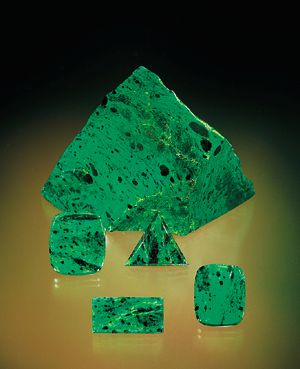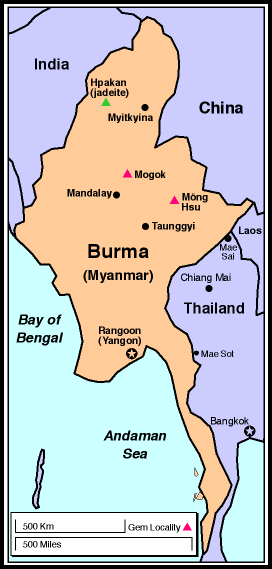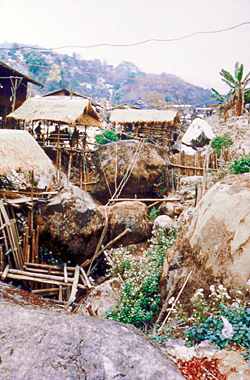|

The Gem Spectrum is Pala International’s
free newsletter. Edited by Pala’s own Gabrièl
Mattice, it is filled with interesting articles on various
aspects of gems and minerals.
We
distribute The Gem Spectrum free
within the United States to members
of the gem and jewelry trades. If
you would like to be added to our mailing
list, please contact us.


Tucson, February 1997 was the
first time many people had ever seen it. At first glimpse
one gets the impression that this opaque, vivid, mossy
green, material is somehow related to jade; and although
it does indeed form within the jade deposits of Hpakan,
Upper Burma, maw-sit-sit is a very different cousin.
It
was in 1962 when Dr. Edward Gübelin
first noticed the material was being referred
to as maw-sit-sit, which was in fact, the
mining area from where it originated. Then,
as well as today, classification would
prove to be quite a challenge due to maw-sit-sit’s
unique composition. In this issue of the Gem
Spectrum, we will attempt to help you
understand this most unique gem material.
Gemology
Maw-sit-sit may be distinguished from jadeite and nephrite by its appearance
as well as its physical and optical properties. It has a refractive
index that ranges from 1.52 (most common) to 1.74 (least common)
depending on the aggregate mineral composition. The density is therefore
also somewhat variable, falling between 2.5–3.5g/cm3.
Most cutters agree that the hardness falls between 6 and 7 on the
Mohs’ hardness scale.
 |
| Rough and cut maw-sit-sit (Photo:
Harold & Erica Van Pelt) |
|
Its
color is most probably caused by the presence of chromium.
Dr. Vince Manson, of the GIA, first suggested in 1979 (based
on unpublished data) that maw-sit-sit might contain ureyite,
which is a sodium chromium pyroxene (NaCrSi206)
where chromium (Cr) replaces aluminum (Al) in the chemical
composition. Ureyite, which was named in honor of Professor
H.C. Urey, is today properly termed kosmochlor. The name
kosmochlor (green from outer space) is derived from the fact
that it was originally found only in meteorites. Dr. Henri
Hanni, of the SSEF, in Basel Switzerland, noted in 1986 (based
on unpublished data) that maw-sit-sit is composed of six
main components. They are as follows: chromite, ureyite,
chrome-jadeite, symplektite, chrome amphibole, and a matrix
of lighter minerals.
Geology & mining
Maw-sit-sit is an aggregate of numerous minerals found in the famous
jade mining region of Tawmaw in the Himalayan foothills of northwestern
Burma. This small mining area lies approximately half a mile northwest
of the village of Namshamaw. The maw-sit-sit mining area is found
in part of what is known as the Namshamaw dike. Maw-sit-sit, like
the jadeite found in this region was formed due to high pressure
regional metamorphism. This region lies on a plateau at an elevation
of approximately 3000 feet within the Uru river drainage basin.
Maw-sit-sit
is a byproduct of jadeite mining and is quite rare in comparison
to jade. The mining techniques used today are similar to those
employed three decades ago when Dr. Gübelin first stumbled upon
the unique gem material, with the exception of modern machinery
used to excavate and tunnel through the thick overburden.
Production
has increased recently with demand, however, fine quality
maw-sit-sit remains difficult to acquire. There are actually
two types of maw-sit-sit being found:
- Maw-sit-sit – the rich green
hue with a medium tone containing contrasting black streaks
or spots
- Kyet Tayoe – the lighter apple
green hue with a fainter tone containing little or no black
streaks or spots
Of the two, maw-sit-sit is certainly
more attractive. Until demand increases, it will be difficult
to determine the potential supply but thus far it seems to
still be quite a rare occurrence.
More about the Myanmar name change
Myanmar, which was once (until only a few short years ago) a nearly inaccessible
country, is now becoming a mechanized nation booming with western
influence . This endearing country with its sacred adherence to religion
and tradition has undergone many changes.
In
1989 the official English name of the country was changed from the
Union of Burma to the Union of Myanmar. There has actually been no
change in the Burmese name for the country since Myanmar is actually
the country’s official name and is found documented in Marco Polo’s
early 13th century writings. In Burmese literary contexts, “Myanmar” is
used to refer to the whole country. Note: As of this printing (May,
1997), President Clinton imposed a ban on new U.S. investment in Myanmar
charging that Burma’s leaders have refused to open a political
dialogue with Burmese democrats including Nobel Peace Prize winner
Aung San Suu Kyi.
Geography
Myanmar has an area of 671,000 sq km, between Thailand and Laos to the
east, India and China bordering the north, and Bangladesh to the
west. The Tropic of Cancer crosses the country just above Mogok while
intersecting also with the Chin, Kachin and Shan states. The Himalayas
rise to the north of Myanmar where at the border between Tibet and
Myanmar stands Jkakabo Rasi; which rises to a grand 5889 meters and
is the highest mountain in South-East Asia. From the earliest mining
days, Myanmar has supplied an endless bounty of gem materials which
ornament our surroundings as well as our bodies. Now in less supply,
fine rubies, sapphires, and spinels, which find there way out of
the country, command much higher prices. The diversity of Myanmar’s
gem bearing mineral deposits have always offered countless possibilities
to the creative designer and maw-sit-sit is proving to be no exception.

|


A delight for the eyes and a challenge for the cutter! This multi-toned
opaque material is made up of green and black pyroxenes and white
albite which constitutes a single stone with varying hardness’ and
toughness. It is most efficient to cut maw-sit-sit on diamond laps
as they cut through most components equally. Even then, “soft
spots,” usually the lighter green area, grind away more quickly
and necessitates extreme caution when cutting to exact specifications.
Pre-polishing is extremely important and is best accomplished on
soft diamond impregnated pads, with a final polish of 50,000 grit.
Plenty of water and high speed rpms can smooth out the pulling
and undercutting so common in a gem material comprised of so many
different minerals. Happily, however, maw-sit-sit has none of the
toxic properties encountered in malachite. A final finish similar
to jadeite is possible in the finer materials but it must be understood
that some leeway should be observed in this area as each piece
cuts differently then the one before. Thus is the charm of maw-sit-sit.
Meg Berry |

 |
| Map of Upper Burma showing the
jade mines in the far north. Maw-sit-sit is mined
in the vicinity of Hpakan. (map © Richard
Hughes) |
|

Updating the Mogok area’s underground
mining methods
On my last
trip into Mogok, Dr. Saw Naung U had urged
me to visit the famous “insurgent” mine – “Ka
Doke Dat.” While this mine was outside
a government protected area, the doctor assured
me that I would be safe if he was my escort.
The kind doctor had extended this invitation
on my previous trips (11 to be exact) but time
had always prohibited it. This time I was determined
to take him up on it, I might be able to get
a ruby crystal in situ.
We
arrived at the mine via rugged roads that parallel
all the various shafts that go down the contact
zone. I noticed many local women waiting along
the perimeter of the mining area and was told
that they were waiting for the miners who had
already sorted for large rubies below. At the
end of their shift, they will gather up the
rocks of white marble material into buckets.
The buckets are then given to the ladies who
take them home and carefully re-sift them for
smaller stones. After their sorting, the remaining
white marble gravel is thrown outdoors. As
a result of this daily ritual, the entire village
looks as though it’s been sprinkled with
crystalline snow. It is spectacular in daylight.
The
mine zone is perhaps two kilometers long,
and is divided into approximately 30 areas.
They are mining down deep on the contact
zone formed between the coarsely crystalline
marble and the so-called Mogok gneiss. The
contact metamorphic zone that contains rubies in
situ dips steeply (as much as 45 degrees
in some areas). The zone that contains the
rubies is about two feet thick, however,
rubies are very rare and interspersed. Most
of the ruby crystals are less than one gram
and not of gem quality.
I
was the first American allowed to go down
into the Ka Doke Dat Mines. I chose the second
deepest one, and I must say, that the native
engineering is indomitable. Descending down
a series of over 45 bamboo ladders, I found
not even one with a loose rung or any movement.
My guide informed me that the bottom was
580 feet on a measured tape from the surface.
A series of small winches would bring up
the buckets one by one with broken pieces
of marble from the working face. The faces
are worked with an electric drill, which
have tungsten carbide bits, since the marble
is rather soft. They drill in about 2 1/2
feet, stick in 1 1/2 sticks of dynamite,
and blast. I am sure many rubies are damaged
this way; however, by working open faces
and blasting large sections down one at a
time, they expertly keep the breakage to
a minimum.
 |
Opening 7-B at
Mogok’s Ka Doke Dat mine.
(Photo: Bill Larson) |
|
This
mine would be impossible to be economical,
except for the fact that it has been worked
by the insurgents. The dream of finding a great
ruby has been kept alive by one of the 30 pits
each day producing something of value. Unfortunately,
I did not see anything good this day; however,
there had been a few pieces in the weeks before.
I was allowed to buy a specimen which has now
been sold to the Harvard University Collection.
With time and energy, I am sure that the very
intelligent Burmese will indeed start preserving
some excellent mineral specimens. We may soon
see some wonderful pieces for our museums as
more and more people discuss what is interesting
for the world market. The problem that we have
encountered so far, is that the pieces sell
way beyond the prices that most mineral collectors
have been willing to pay.
Burma,
with all of its differences, continues to
be a never-ending learning process, and once
in a while, we find something that is most
exciting. But let me leave you on a humorous
note. My friend Yew Sett has a $50,000 garden.
How did this come about? He paid this amount
for a beautiful ruby crystal specimen which
measured 2 x 2.5 inches. It was
a perfect hexagonal pyramid on white marble
that looked like it would produce a gemmy
ruby if cut. Maybe not realizing the money
a mineral specimen of this caliber would
fetch, he gave it to his cutters hoping to
retain a fine cut stone. The grinding commenced...
and continued... and continued... until all
that was left was ruby dust. This he proceeded
to sprinkle over his garden. Smiling, he
admits it is the most expensive fertilizer
a gardener has ever known.

|

“Of all scientific subjects, geology, geologists, and gemologists, are probably
the least narrow and prosily materialistic. In the pursuit of geological studies,
gemology, par excellence, there comes into play a mysterious inspirational power
derived from close association with Nature’s huge creations and forces.
Set with sublimest scenery, in a supernatural atmosphere of beauty and with the
marvelous unfolding of Nature’s ways, the awakening consciousness of the
eternal powers, the majesty of conception, the everlastingness of time, material,
force and movement, and of resulting life itself, create an intimate approach
along the paths of science, to the vary gateway of the unfathomable secrets and
mysteries of life. These awe-inspiring, magnetic influences and the dawning comprehension
of universal greatness, transmitted through these poetic and scientifically romantic
contacts, are those who cultivate the reverential expanding vision. You who strike
through and bring to the surface in the fullest refinement of the finer traits
and aspirations. Making he or she at his or her best... The Gemological scientist.”
Sir
Frederick Gleason Corning
1920 |

Special thanks to...
- Edward Boehm,
Joeb Enterprises, for the gemology segment
|



